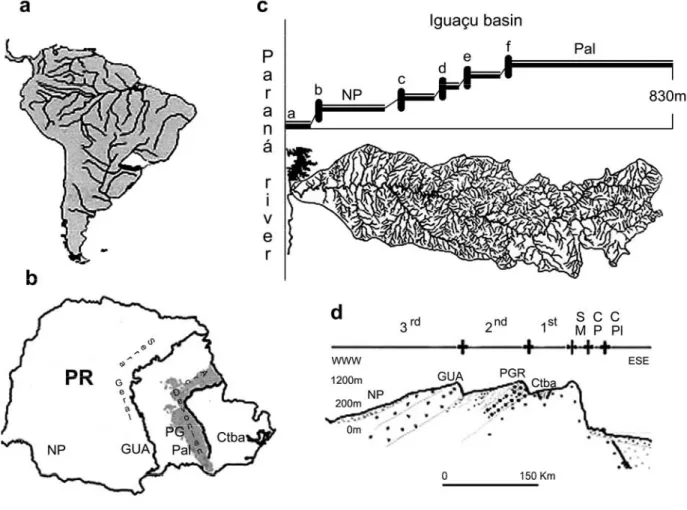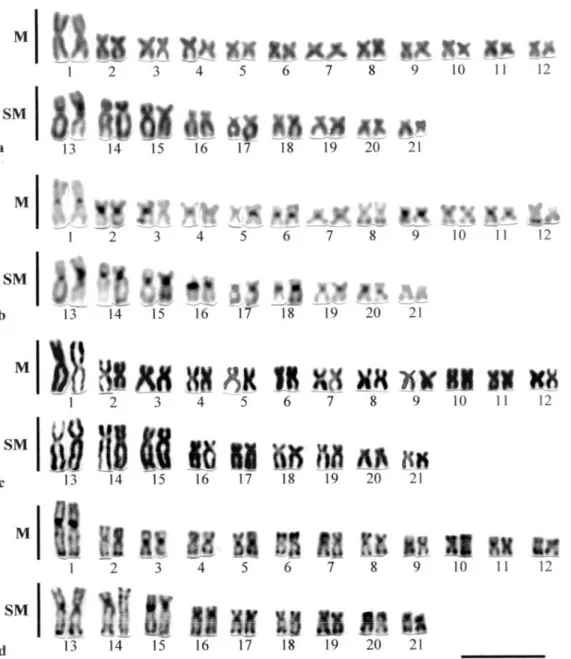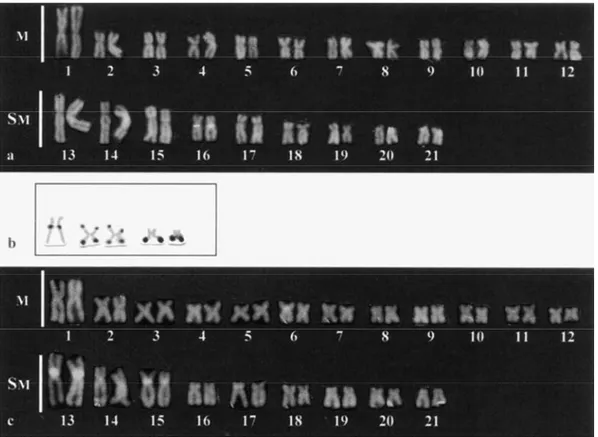Vol.49, n. 2 : pp. 297-303, March 2006
ISSN 1516-8913 Printed in Brazil BRAZILIAN ARCHIVES OF
BIOLOGY AND TECHNOLOGY
A N I N T E R N A T I O N A L J O U R N A L
Cytogenetics and Biogeography: Considerations about the
Natural Origin of
Hoplias malabaricus
(Characiformes,
Erythrinidae) on the Iguaçu River
Marcelo Ricardo Vicari1∗, Rubens Pazza1, Roberto Ferreira Artoni2, Vladimir Pavan Margarido3 and Luiz Antonio Carlos Bertollo1
1
Universidade Federal de São Carlos; Departamento de Genética e Evolução; Via Washington Luís, km 235; C. P. 676; 13565-905; vicarimr@bol.com.br; São Carlos - SP - Brasil. 2 Universidade Estadual de Ponta Grossa; Departamento de Biologia Estrutural; Molecular e Genética; 84030-900; Ponta Grossa - PR - Brasil.
3
Universidade Estadual do Oeste do Paraná; Centro de Ciências Biológicas e da Saúde; 85814-110; Cascavel - PR - Brasil
ABSTRACT
Hoplias malabaricus (trahyra) is a widespread fish species over the Neotropical region with diversified inter-populational karyotypes (cytotypes), which may correspond to a species complex. Despite the wide distribution in the South American basins, some authors have questioned its natural origin in the Iguaçu river, an important Brazilian river basin which is characterized by several endemic fish species. We have analyzed the karyotype of H. malabaricus from different collection sites of this river, by conventional and banding methods. Our results, in addition to our previous data concerning geographic distribution of the cytotypes, contribute to better understand the origin of H. malabaricus on the Iguaçu river, reinforcing the proposition that it is a natural fish species in this river basin.
Key words: Chromosome evolution, karyotypes distribution, endemism
∗ Author for correspondence
INTRODUCTION
The fish fauna of the Iguaçu river is well known for its high degree of endemism and for the absence of several fish families common in other Brazilian basins (Júlio Jr. et al., 1997). The Iguaçu falls have acted as an efficient geographical barrier between the ichthyofauna from the first and the second plateaus along most of the river length (Maack, 1968). Garavello et al. (1997) described 36 endemic species, 11 introduced species and 3 exotic species at Iguaçu river. The occurrence of
Hoplias malabaricus in this basin, popularly
known as traíra, is quite controversial being referred as an introduced species (Garavello et al. op. cit.). Dergam et al. (1998) stated that the
introduction of H. malabaricus in the Iguaçu river
could have been done from the Tibagi headwaters, based on the similar genetic patterns of the populations, as well as in the proximity of both rivers.
Cytogenetical data clearly indicate that H.
malabaricus is a complex species, probably related
al., 1994; Bertollo et al., 2000). Bertollo et al. (2000) differentiated seven distinct cytotypes in this fish group, based on their chromosome numbers and morphology and the absence or occurrence of distinct sex chromosome systems. The present paper aimed to contribute for a better
understanding of the biogeography of H.
malabaricus and its probable natural origin on the
Iguaçu river basin.
MATERIAL AND METHODS
Forty-six specimens of Hoplias malabaricus were
sampled in the main stream and in marginal lakes belonging to the Iguaçu river. Twelve specimens were collected from a population in the western region of the Paraná State (Brazil), in the township of Nova Prata do Iguaçu. Thirty-four specimens were captured from a population in the eastern region of the same state, in the township of Palmeira (Fig. 1).
Metaphases were obtained according to Bertollo et
al. (1978), using a cell suspension from the
anterior kidney, after in vivo treatment with
colchicine (1ml/100g body weight). The detection of the nucleolar organizing regions (NORs) and the constitutive heterochromatin followed the methods described by Howell and Black (1980) and Sumner (1972), respectively. Chromomycin A3 staining was performed according to Schmid (1980). Chromosomes were arranged by size and shape, according to Levan et al. (1964) and the cytotypes were classified as stated by Bertollo et al. (2000).
RESULTS
The two populations analyzed, from now named eastern and western populations, showed the same karyotypic macrostructure, with a diploid number of 2n=42, with 24 metacentric (M) plus 18
submetacentric (SM) chromosomes. The
karyotypes were identical between the sexes, without any evidence of heteromorphic sex chromosomes (Figs. 2a, c).
Ag-NORs (silver stained nucleolar organizing regions) were variable in number in both populations. Two to seven Ag-NORs were evidenced in the eastern population and three to eight in the western population, generally located on the telomeric region of the long arm of meta/submetacentric chromosomes. Specifically in the eastern population, it was found Ag-NOR in the telomeric region of the long arm of the smaller submetacentric chromosome pair and an interstitial Ag-NOR in the long arm of the only one
homologue of the 16th pair (Fig. 3b). Bi-telomeric
Ag-NORs (NORs located on the two telomeric
regions of a same chromosome) were also found in both populations (Fig. 3b).
Constitutive heterochromatin was evidenced in the
centromeric/pericentromeric regions of all
chromosomes and, eventually, in a telomeric position (Figs. 2b, d). In the eastern population, the 16th chromosome pair showed a polymorphic GC-rich heterochromatic region in agreement with the NOR location (Fig. 3a). In the western population, GC-rich heterochromatic regions were detected in the centromeric region of the 6th, 13th and 15th chromosome pairs, without association with NORs (Fig. 3c).
Figure 3 - Chromomycin A3 stained karyotypes (a,c) of Hoplias malabaricus from the eastern and
western populations, respectively, showing the GC-rich chromosome segments. (b) Representative chromosomes bearing Ag-NORs (from the eastern population) showing bitelomeric NORs in two metacentric ones. Bar=5 µm.
DISCUSSION
Both eastern and western populations showed a karyotypic structure that corresponds to cytotype A in the Bertollo’s classification (Bertollo et al.,
2000). However, some chromosomal
differentiation was found between the populations,
particularly in respect of the Ag-NORs and GC-rich regions locations. Indeed, the Ag-NORs located on the telomeric region of the smaller submetacentric chromosomes and in the interstitial
region of the 16th chromosome (Fig. 3b) were only
seen in the eastern population. In fact, interstitial
On the other hand bitelomeric NORs, as those observed in both eastern and western populations,
have been commonly found in H. malabaricus
cytotypes (Bertollo, 1996; Born and Bertollo, 2001), representing a probable sinapomorphic condition for this fish group. Concerning the distinct numbers of Ag-NORs found in the eastern (2-7) and in the western (3-8) populations, although this variation may be related to a differential expression of some rDNA cistrons, the results may also represent real karyotypic differences, as verified by Born and Bertollo (2001) and Vicari et al. (2003) for distinct H.
malabaricus populations belonging to cytotype A.
Two classes of heterochromatin were observed in both populations. The first one possesses a GC-rich DNA, which is present only in few chromosomes. This heterochromatin was not found to be related to NORs in the western population, which might represent an exception feature amongst fishes (Souza et al., 1996; Artoni et al., 1999; Margarido and Galetti Jr., 2000). Indeed, GC-rich heterochromatin associated with NORs is a common character in fish species (Mayr et al., 1985; Schmid and Guttenbach, 1988; Phillips and Hartley, 1988; Sola et al., 1992). The location of this heterochromatin in distinct chromosome pairs, besides its relation with NOR only in the eastern population, are good evidences that a karyotypic diversification have already occurred at some degree between the populations. A second heterochromatin class, present on the centromeric region of most chromosomes, does
not present any fluorescent signal after
chomomycin A3 staining.
Lemos et al. (2002) found sympatric populations
of H. malabaricus belonging to cytotype A (2n=42
chromosomes without a sex chromosome system) and cytotype B (2n=42 chromosomes with a XX/XY sex chromosome system) in the Iguaçu
river, the latter being also found in coastal
Brazilian basins (Bertollo et al., 2000). The
occurrence of the cytotype B in the Iguaçu basin could be explained by dispersion from the coastal basins, as a consequence of a preterit contact between the basins, a headwater capture in small streams or even an occasional communication during the wet seasons (Lemos et al., 2002). Whereas cytotype A show a wide distribution along the Iguaçu basin (Bertollo et al., 2000; Lemos et al., 2002; present study), cytotype B was found thus far only in a restricted area of the first plateau of that basin (Fig. 1d). Thus, it is likely
that the dispersal event of cytotype B have a recent origin, in addition to the low vagility of H.
malabaricus and the possible geological barrier
formed by the Ponta Grossa arc, that is, the Devonian scarp that delimits the first and the second plateaus of the Paraná State (Fig. 1b). The Iguaçu river basin is not recent in origin. As other tributaries of the Paraná river, as well as the Paraná river itself, its origin dates from the basaltic settlement during the formation of Serra Geral, in the Cretaceous (Potter, 1997). Its fish fauna finds itself isolated from that of the Paraná river due to the formation of the Iguaçu falls, approximately 22 millions years ago (Oligo-Miocene period). This fact may have favored the speciation and the considerable degree of endemism of that basin (Severi and Cordeiro 1994). H. malabaricus has been considered a non-native species in the Iguaçu basin. However, cytogenetics data show that cytotype A finds itself broadly distributed in Brazilian southeast and southern regions (where the Iguaçu basin is inserted), reaching Uruguay and Argentina (Bertollo et al., 2000). A priori, it
seems very unlikely that H. malabaricus was
originally absent from the Iguaçu basin, although present in many other neighboring basins. Thus, the endemism of the Iguaçu river appears to be valid for many fish species, but does not seem to
apply for others, as H. malabaricus (Lemos et al.,
2002). Our hypothesis is that H. malabaricus
cytotype A is a native form in the Iguaçu river, and that the karyotypic diversification of the populations here analyzed is a throughout time consequence of vicariant events.
ACKNOWLEDGEMENTS
This study was supported by FAPESP (Fundação de Amparo à Pesquisa do Estado de São Paulo), CNPq (Conselho Nacional de Desenvolvimento Científico e Tecnológico), Fundação Araucária
(Fundação de Apoio ao Desenvolvimento
RESUMO
Hoplias malabaricus (traíra) é uma espécie de
peixe com ampla distribuição pela região
Neotropical e alta diversidade cariotípica
interpopulacional (citótipos), que podem
corresponder a um complexo de espécies. Apesar
da sua ampla distribuição pelas bacias
hidrográficas da América do Sul, alguns autores têm questionado sua origem natural no rio Iguaçu, uma importante bacia hidrográfica brasileira que é caracterizada pela presença de várias espécies de peixes endêmicas. Assim, nós temos analisado o cariótipo de H. malabaricus de diferentes locais de coleta neste rio por métodos convencionais e bandamentos cromossômicos. Nossos resultados, em adição a dados prévios a respeito da distribuição geográfica dos citótipos contribuem
para um melhor entendimento da origem de H.
malabaricus no rio Iguaçu, reforçando a proposta que esta é uma espécie de peixe natural desta bacia hidrográfica.
REFERENCES
Artoni, R. F.; Molina, W. F.; Bertollo, L. A. C. and Galetti Jr., P. M. (1999), Heterochromatin analysis in the fish species Liposarcus anisitsi (Siluriformes) and Leporinus elongatus (Characiformes). Genetics and Molecular Biology, 22, 39-44.
Bertollo, L. A. C. (1996), The nucleolar organizer regions of Erythrinidae fish. An uncommon situation in the genus Hoplias. Cytologia, 61, 75-81.
Bertollo, L. A. C.; Takahashi, C. S. and Moreira-Filho, O. (1978), Cytotaxonomic considerations on Hoplias lacerdae (Pisces, Erythrinidae). Brazilian Journal of Genetics, 1, 103-120.
Bertollo, L. A. C.; Takahashi, C. S. and Moreira-Filho, O. (1983), Multiple sex chromosomes in the genus Hoplias (Pisces, Erythrinidae). Cytologia, 48, 1-12. Bertollo, L. A. C.; Born, G. G.; Dergam, J. A.;
Fenocchio, A. S. and Moreira-Filho, O. (2000), A biodiversity approach in the Neotropical Erythrinidae fish, Hoplias malabaricus. Karyotypic survey, geographic distribution of cytotypes and cytotaxonomic considerations. Chromosome Research, 8, 603-613.
Born, G. G. and Bertollo, L. A. C. (2001), Comparative cytogenetics among allopatric populations of the fish,
Hoplias malabaricus. Cytotypes with 2n=42
chromosomes. Genetica, 110, 1-9.
Dergam, J. A.; and Bertollo, L. A. C. (1990), Karyotypic diversification in Hoplias malabaricus (Osteichthyes, Erythrinidae) of the São Francisco and Alto Paraná basins, Brazil. Brazilian Journal of Genetics, 13, 755-766.
Dergam, J. A.; Suzuki, H. I.; Shibatta, O. A.; Duboc, L. F.; Júlio Jr., H. F.; Giuliano-Caetano, L. and Black IV, W. C. (1998). Molecular biogeography of the neotropical fish Hoplias malabaricus (Erythrinidae: Characiformes) in the Iguaçu, Tibagi, and Paraná rivers. Genetics and Molecular Biology, 21, 493-496. Garavello, J. C.; Pavanelli, C. S. and Suzuki, H. I.
(1997), Caracterização da ictiofauna do rio Iguaçu. In: Agostinho, A. A. and Gomes, L. C. (Ed.). Reservatório de Segredo: Bases Ecológicas para o Manejo. Maringá: Universidade Estadual de Maringá. pp. 61-84.
Howell, W. M. and Black, D. A. (1980), Controlled silver-staining of nucleolus organizer regions with a protective colloidal developer: a 1-step method. Experientia, 36, 1014-1015.
Julio Jr., H. F.; Bonecker, C. C. and Agostinho, A. A. (1997), Reservatório de Segredo e sua inserção na bacia do rio Iguaçu. In: Agostinho, A. A. and Gomes, L. C. (Ed.). Reservatório de Segredo: Bases Ecológicas para o Manejo. Maringá: Universidade Estadual de Maringá. pp. 1-17.
Lemos P. M. M.; Fenocchio, A. S.; Bertollo, L. A. C. and Cestari, M. M. (2002), Karyotypic studies on two Hoplias malabaricus populations (Characiformes, Erythrinidae) of the 2n = 42 group, from the first plateau of the Iguaçu river basin (Paraná State, Brazil). Caryologia, 55, 193-198.
Levan, A.; Fredga, K. and Sandberg, A. A. (1964), Nomenclature for centromeric position on chromosomes. Hereditas, 52, 201-220.
Maack, R. (1968), Geografia Física do Estado do Paraná. Rio de Janeiro: J. Olympio. v. 2.
Margarido, V. P. and Galetti Jr., P. M. (2000), Amplification of a GC-rich heterochromatin n the freshwater fish Leporinus desmotes (Characiformes, Anostomidae). Genetics and Molecular Biology, 23, 569-573.
Mayr, B.; Kalat, M. and Ràb, P. (1985), Localization of NORs and counter-stain-enhanced fluorescence studies in Perca fluviatilis (Pisces, Percidae). Genetica, 67, 51-56.
Phillips, R. and Hartley, S. E. (1988), Fluorescent banding patterns of the chromosomes of the genus Salmo. Genome, 30, 193-197.
Potter, P. E. (1997), The mesozoic and cenozoic paleodrainage of South America: a natural history. Journal of South American Earth Science, 10, 331-344.
Schmid, M. (1980), Chromosome banding in Amphibia. IV. Differentiation of GC- and AT-rich chromosome region in Anura. Chromosoma, 77, 83-103.
Schmid, M. and Guttenbach, M. (1988), Evolutionary diversity of reverse fluorescent chromosome bands in vertebrates. Chromosoma, 97, 101-114.
Severi, W. and Cordeiro, A. A. M. (1994), A bacia hidrográfica do rio Iguaçu. In: Catálogo de Peixes da Bacia do Rio Iguaçu. Curitiba: IAP/GTZ. pp. 1-6. Sola, L.; Rossi, A. R.; Iaselli, V.; Rash, E. M. and
Mônaco, P. J. (1992). Cytogenetics of bisexual/unisexual species of Poecilia. II. Analysis of heterochromatin and nucleolar organizer regions in Poecilia mexicana mexicana by C-banding and DAPI, quinacrine, chromomycin A3 and silver
staining. Cytogenetic and Cell Genetics, 60, 229-235. Souza, I. L.; Moreira-Filho, O. and Galetti Jr., P. M.
(1996), Heterochromatin differentiation in the characid fish Astyanax scabripinnis. Brazilian Journal of Genetics, 19, 405-410.
Sumner, A. T. (1972), A simple technique for demonstrating centromeric heterochromatin. Experimental Cell Research, 75, 304-306.
Vicari, M. R.; Artoni, R. F. and Bertollo, L. A. C. (2005), Comparative cytogenetics of Hoplias malabaricus (Pisces, Erythrinidae). A population analysis in adjacent hydrographic basins. Genetics and Molecular Biology [in press].


